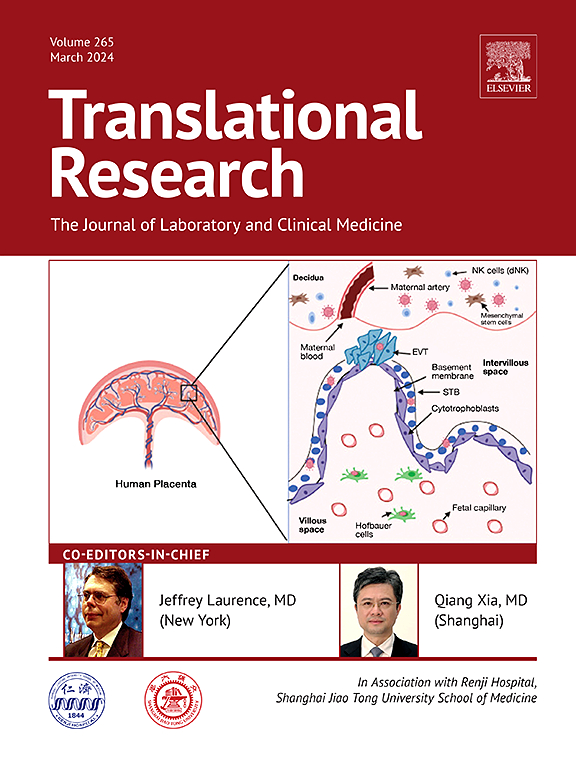Canagliflozin inhibits hedgehog interacting protein (Hhip) induction of tubulopathy in diabetic Akita mice
IF 5.9
2区 医学
Q1 MEDICAL LABORATORY TECHNOLOGY
引用次数: 0
Abstract
Renal hedgehog interacting protein (Hhip) activates sodium-glucose cotransporter 2 (Sglt2) expression and promotes tubular senescence in murine diabetic kidney disease (DKD), yet its underlying mechanism(s) are poorly understood. Here we study the effect of the SGLT2 inhibitor, canagliflozin on tubulopathy (fibrosis and apoptosis) in Akita/HhipRPTC-transgenic (Tg) mice with overexpression of Hhip in their renal proximal tubular cells (RPTCs) and its relevant mechanisms. The DKD-tubulopathy with pronounced Sglt2 expression was aggravated in the kidney of Akita/HhipRPTC-Tg cf. Akita/non-Tg mice. A strong association was observed between Hhip and tubular senescence in Nephroseq from the Nakagawa chronic kidney disease study. Both in vivo and in vitro, excessive Hhip in RPTCs triggered RPTC senescence (polyploidization and cytoskeleton destabilization) and released extracellular vesicles (EVs) carrying Hhip (EVsHhip), most of which were apoptotic bodies (ABsHhip) or microvesicles (MVsHhip) and little exosomes (EXOsHhip). Further, Hhip stimulated β2-microglobulin, which further interacts with EVsHhip, together facilitating RPTC turn-over from cellular senescence to fibrosis and/or apoptosis, ultimately leading to advanced tubulopathy. In contrast, canagliflozin administration offset the action of Hhip in RPTCs, thereby preventing DKD progression. In conclusion, canagliflozin prevented excessive Hhip-mediated tubulopathy, possibly via the inhibition of excessive Hhip carried by extracellular vehicles in DKD.
卡格列净抑制刺猬相互作用蛋白(hip)诱导糖尿病秋田小鼠小管病变。
肾刺猬相互作用蛋白(hip)激活钠-葡萄糖共转运蛋白2 (Sglt2)表达并促进小鼠糖尿病肾病(DKD)的小管衰老,但其潜在机制尚不清楚。本研究研究SGLT2抑制剂canagliflozin对hhiprptc转基因(Tg)小鼠肾近端小管细胞(RPTCs)中hip过表达的Akia/ hhiprptc转基因(Tg)小鼠小管病变(纤维化和凋亡)的影响及其相关机制。与Akita/HhipRPTC-Tg相比,Akia/非tg小鼠肾脏中Sglt2明显表达的dkd -小管病变加重。来自中川慢性肾病研究的hip和肾小管衰老之间的强烈关联。在体内和体外实验中,RPTC中过量的hip触发RPTC衰老(多倍化和细胞骨架不稳定),并释放携带hip的细胞外囊泡(evship),其中大多数是凋亡小体(abship)或微囊泡(mvship)和少量外泌体(exoship)。此外,hip刺激β2微球蛋白,其进一步与evship相互作用,共同促进RPTC从细胞衰老转变为纤维化和/或凋亡,最终导致晚期小管病变。相反,canagliflozin在rptc中抵消了hip的作用,从而阻止了DKD的进展。总之,卡格列净可能通过抑制DKD中细胞外载体携带的过量Hhip来预防过量Hhip介导的小管病变。
本文章由计算机程序翻译,如有差异,请以英文原文为准。
求助全文
约1分钟内获得全文
求助全文
来源期刊

Translational Research
医学-医学:内科
CiteScore
15.70
自引率
0.00%
发文量
195
审稿时长
14 days
期刊介绍:
Translational Research (formerly The Journal of Laboratory and Clinical Medicine) delivers original investigations in the broad fields of laboratory, clinical, and public health research. Published monthly since 1915, it keeps readers up-to-date on significant biomedical research from all subspecialties of medicine.
 求助内容:
求助内容: 应助结果提醒方式:
应助结果提醒方式:


